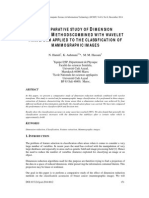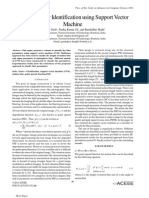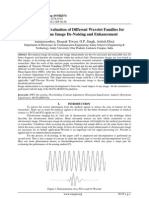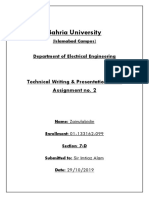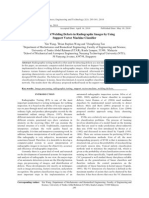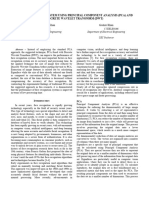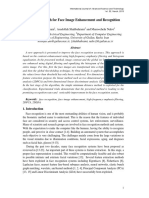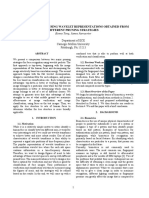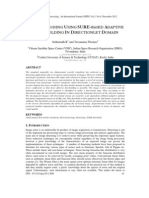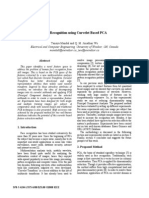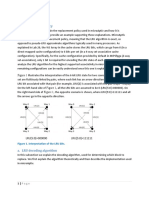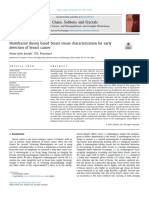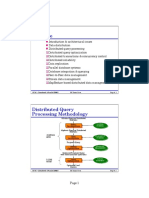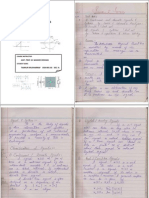Wavelet Based Face Recognition System
Wavelet Based Face Recognition System
Uploaded by
rednivsajCopyright:
Available Formats
Wavelet Based Face Recognition System
Wavelet Based Face Recognition System
Uploaded by
rednivsajOriginal Description:
Original Title
Copyright
Available Formats
Share this document
Did you find this document useful?
Is this content inappropriate?
Copyright:
Available Formats
Wavelet Based Face Recognition System
Wavelet Based Face Recognition System
Uploaded by
rednivsajCopyright:
Available Formats
NATIONAL CONFERENCE ON EMERGING TRENDS IN ENGINEERING SCIENCE & TECHNOLOGY (NCETEST-2014)
MARCH 29th -30th, 2014
COLLEGE OF ENGINEERING ROORKEE (COER), ROORKEE, INDIA
Performance Analysis of Wavelet Subband Based
Face Recognition System
1
Mr. B. D. Patel, 2Varun Deep Singh and 3Shubham Agrawal
College of Engineering Roorkee/Electronics & Telecom. Dept., Roorkee, India.
Email: bdpatel@coer.ac.in
2,3
College of Engineering Roorkee/Electronics & Telecom. Dept., Roorkee, India.
Email:2vdeep91@gmail.com, 3agrawalatshubham94@gmail.com
Abstract A new face recognition technique using
Wavelet Subband is proposed. We extract image
features of facial images using Discrete Wavelet
transform (using Cohen Daubechies Function
window) by decomposing face image in subbands 1 to
8. Here we apply DWT on each image in ORL
database to evaluate the performance. The DWT is
computed by successive lowpass and highpass filtering
of the discrete time-domain signal. Then the features
LL3 (i.e the low-low coefficients obtained at 3rd level
of DWT) is analyzed by the classifiers J48 and Naives
classifier. For each person 10 images are used to train
the classifier. The results show that for the entire
wavelets, subband LL3 gives a good classification
accuracy.
Index Terms Classifiers J48 and Naives, Discrete
Wavelet Transform, lowpass coefficients extraction
using Cohen Daubechies Function(CDF), Classifier
performance on LL3 coefficients, Conclusion.
I. INTRODUCTION
Face recognition has been an area of importance
in recent years, because of its benefit of being a
reflexive, non-invasive system to verify
personal identity in a natural and friendly way.
Primary areas of its application are surveillance,
access control and security monitoring systems.
Face recognition is one of the most challenging
tasks in image processing because its
applications requires a high degree of accuracy.
Till date many techniques and methods have
been suggested for accurate face recognition of
an individual. A Comprehensive review of
literature has been presented by Zhao et al. [1]
on this. Methods of face recognition can be
divided into two approaches namely, feature
geometry based and subspace analysis
techniques.
In feature geometry based approach,
recognition is based on the relationship between
human facial features, for example separation
between eyes, width of jaw, distance between
nose and cheeks or face boundary etc. However
these techniques have limited reliability as they
require a correct positioned image of an
individual for recognition.
In Subspace analysis approach we analyse the
intensity variation in given image of face. This
can be achieved by techniques like variance,
applying transforms to extract coefficients etc.
By applying these techniques dimensionality of
a given image is greatly reduced because the
redundant data is removed. Sometimes we
require only the key features to recognize a
given image. This makes subspace methods
more popular for application nowadays.
General face recognition methods consists of
a feature extractor (like PCA, Wavelet
decomposer) to reduce the size of input and a
classifier like Naive, SVM (Support Vector
Machines), Neural Networks, Nearest Distance
Classifiers to find the features which are distinct
for each individual.. Low computation time by
reduction in data is an important advantage.
In this study, we chose wavelet
decomposition as main technique for data
reduction and feature extraction, and analysis of
accuracy of recognition using classifiers
(Naives Bayes and J48). We extract image
features of facial images by use of wavelet
transform (using Cohen Daubechies Function)
by decomposing face image in subbands 1 to 8.
These features are analyzed by using Naives
and Bayes classifier.
The remainder of the paper is organized as
follows: next section introduces to discrete
wavelet transform and the classifiers J48 and
Naive. In Section III we discuss the proposed
method. Results obtained are presented in
NCETEST-2014
NATIONAL CONFERENCE ON EMERGING TRENDS IN ENGINEERING SCIENCE & TECHNOLOGY (NCETEST-2014)
MARCH 29th -30th, 2014
COLLEGE OF ENGINEERING ROORKEE (COER), ROORKEE, INDIA
section IV. Finally, conclusions are given in
section V.
II. DISCRETE WAVELET TRANSFORM &
CLASSIFIERS
A. Discrete Wavelet Transform
A discrete wavelet transform (DWT) is any
wavelet transform for which the wavelets are
discretely sampled.Discrete Wavelet Transform
is a dominant tool used in image processing and
computer vision, due to its ability to capture
localized time-frequency information of an
image[2]. The application of discrete wavelet
transform decomposes data into different
frequency ranges. Thus frequency components
of image are decomposed into subbands . By
application of DWT on these subbands a more
resolution in frequency domain can be obtained.
1D-Discrete Wavelet Transform is given by:
, =
1
2
(1)
2
Where,
j is the power of binary scaling, k is a constant
of the filter and (t) is called mother wavelet
(here CDF)
B. Classifiers
A classifier can be viewed as a function of
block, which assigns one class to each point of
the input space. The input space is thus
partitioned into different class. There are two
classification algorithms used for classification
of coefficients from image.
Decision tree: J48
A decision tree is a predictive machine-learning
model that decides the target value (dependent
variable) of a new sample based on various
attribute values of the available data. The
internal nodes of a decision tree denote the
different attributes; the branches between the
nodes tell us the possible values that these
attributes can have in the observed samples,
while the terminal nodes tell us the final value
(classification) of the dependent variable. [3]
Naive Bayes classifier
The probabilistic classifier based on applying
Bayes' theorem is Naive Bayes. Depending on
the precise nature of the probability model,
Naive Bayes classifiers can be trained very
efficiently in a supervised learning setting. It
uses the method of maximum likelihood for
parameter estimation.It is probabilistic classifier
with the assumption that the attribute values are
conditionally independent of the given target
values. . The model is
1, 2,, =
Figure-1: Multiresolution scheme after 2 and 3 levels of wavelet
transform on an image.
The DWT uses multiresolution filter banks and
special wavelet filters for the analysis and
reconstruction of signals. The 2-D DWT is
computed by successive lowpass and highpass
filtering of the image. By applying 2D DWT on
an image, the image is decomposed into four
subbands LL, LH, HL, HH subbands,
corresponding to approximate , horizontal,
vertical, and diagonal features respectively.
1
()
(2)
Where is a class variable, 1, 2,, are
attribute, Z is scaling factor Bayesian approach is
to assign most probable target value is
given by:
= max ( )
(3)
III.THE PROPOSED METHOD
For a given face image, feature vectors of faces
are extracted through 2-D Discrete Wavelet
Transform (CDF) at LL3 subband[4]. By
application of DWT we obtain dimensional
reduction of data of a given image. The LL3
subband coefficients are then given to
NCETEST-2014
NATIONAL CONFERENCE ON EMERGING TRENDS IN ENGINEERING SCIENCE & TECHNOLOGY (NCETEST-2014)
MARCH 29th -30th, 2014
COLLEGE OF ENGINEERING ROORKEE (COER), ROORKEE, INDIA
classifiers J48 and Naives Bayes to examine the
classification accuracy in each classifier. The
images after application of CDF transform are
shown in the figure 2 (White region is LL3).
IV. RESULTS
Here ORL face database [5] from AT&T
(Olivetti) Research Laboratories, Cambridge
has been used. The database contains 40
individuals with each person having ten frontal
images. We have taken images of only 10
individuals for our experiment. Few sample
face images from this database are shown in
figure.
Figure 2. Wavelet decomposition at level 3.
Figure 4. Few face images from ORL face database.
The results obtained in WEKA software are
tabulated as follows:
S.No
1.
2.
3.
4.
5.
6.
7.
Figure 3: Flowchart of proposed method
In classification 70% data is used for training,
remaining 30% in used in testing. For the
application of the wavelet transform on an
image software used is MATLAB, and for
checking classification accuracy (using J48 and
Naive Bayes) we used WEKA software.
8.
9.
Classification
Accuracy
Percentage
data used for
training
Total Number
of Instances
Correctly
Classified
Instances
Incorrect
Classified
Instances
Mean Absolute
Error
Naives
Decision
and Bayes Tree:J48
Classifier Classifier
93.33
83.3333
70%
70%
30
30
28
25
0.013
0.03333
Root
Mean
Square Error
Relative
Absolute Error
0.1155
0.1826
7.3462
18.3655
Root Relative
Squared Error
38.1147
60.2646
NCETEST-2014
NATIONAL CONFERENCE ON EMERGING TRENDS IN ENGINEERING SCIENCE & TECHNOLOGY (NCETEST-2014)
MARCH 29th -30th, 2014
COLLEGE OF ENGINEERING ROORKEE (COER), ROORKEE, INDIA
V. CONCLUSIONS
We applied wavelet transform on images in
database and compared the performance of two
classifiers (J48 and Naives) using LL3
coefficients .Based on results we observed that
the two classifiers give above 80%
classification accuracy. However we observe
that classification accuracy in Naives Bayes
classifier is more (93.33%), making it more
suitable for classification.
We also observe that at Subband LL3 we
extract good frequency information from an
image. The dimensionality of image is reduced
after application of discrete wavelet transform.
This has the advantage of reducing the storage
size in recognition system; also the recognition
time will also be reduced.
REFERENCES
[1] W. Zhao, R. Chellappa, A. Rosenfeld, and
P.J. Phillips,Face recognition: A literature
survey, CVL Technical Report, University of
Maryland, 2000.
[2]Wikipedia ,the free encyclopedia
http://en.wikipedia.org/wiki/Discrete_wavelet_t
ransform
[3] Chapter 5,CLASSIFICATION METHODS
- University of Minnesota Duluth
http://www.d.umn.edu/~padhy005/Chapter5.ht
ml
[4]Face Recognition based on TwoDimensional PCA on Wavelet Subband by
Kishor S Kinage and S. G. Bhirud
[5] ORL face databases,
http://www.uk.research.att.com/pub/data/orl_fa
ces.zip
NCETEST-2014
You might also like
- Final Year Project - Medical Image Classification Using Support Vector MachineDocument54 pagesFinal Year Project - Medical Image Classification Using Support Vector MachineAbimanyu NN67% (3)
- GUI Implementation of Image Encryption and Decryption Using Open CVDocument4 pagesGUI Implementation of Image Encryption and Decryption Using Open CVRasool ReddyNo ratings yet
- Face Recognition Using DCT - DWT Interleaved Coefficient Vectors With NN and SVM ClassifierDocument6 pagesFace Recognition Using DCT - DWT Interleaved Coefficient Vectors With NN and SVM ClassifiertheijesNo ratings yet
- Brain Image Classification Using Learning Machine Approach and Brain Structure AnalysisDocument7 pagesBrain Image Classification Using Learning Machine Approach and Brain Structure AnalysisAhmed ElmasryNo ratings yet
- Compression Based Face Recognition Using DWT and SVMDocument18 pagesCompression Based Face Recognition Using DWT and SVMsipijNo ratings yet
- 6614 Ijcsit 12Document8 pages6614 Ijcsit 12Anonymous Gl4IRRjzNNo ratings yet
- Blur Parameter Identification Using Support Vector Machine: Ratnakar Dash, Pankaj Kumar Sa, and Banshidhar MajhiDocument4 pagesBlur Parameter Identification Using Support Vector Machine: Ratnakar Dash, Pankaj Kumar Sa, and Banshidhar MajhiidesajithNo ratings yet
- A Face Recognition Scheme Based On Principle Component Analysis and Wavelet DecompositionDocument5 pagesA Face Recognition Scheme Based On Principle Component Analysis and Wavelet DecompositionInternational Organization of Scientific Research (IOSR)No ratings yet
- E I R U R B I R: Fficient Mage Etrieval Sing Egion Ased Mage EtrievalDocument13 pagesE I R U R B I R: Fficient Mage Etrieval Sing Egion Ased Mage EtrievalsipijNo ratings yet
- Different Image Fusion Techniques - A Critical Review: Deepak Kumar Sahu, M.P.ParsaiDocument4 pagesDifferent Image Fusion Techniques - A Critical Review: Deepak Kumar Sahu, M.P.ParsaiCatalina GireadaNo ratings yet
- Image Denoising Using Ica Technique: IPASJ International Journal of Electronics & Communication (IIJEC)Document5 pagesImage Denoising Using Ica Technique: IPASJ International Journal of Electronics & Communication (IIJEC)International Journal of Application or Innovation in Engineering & ManagementNo ratings yet
- Performance Evaluation of Different Wavelet Families For Chromosome Image De-Noising and EnhancementDocument7 pagesPerformance Evaluation of Different Wavelet Families For Chromosome Image De-Noising and EnhancementIOSRJEN : hard copy, certificates, Call for Papers 2013, publishing of journalNo ratings yet
- (IJCST-V3I2P42) :ms. Gayatri K. Bhole, Mr. M. D. JakheteDocument4 pages(IJCST-V3I2P42) :ms. Gayatri K. Bhole, Mr. M. D. JakheteEighthSenseGroupNo ratings yet
- Video Stabilization For A Hand-Held Camera Based oDocument5 pagesVideo Stabilization For A Hand-Held Camera Based osharifuav.ramezaniNo ratings yet
- VLSI-Assisted Nonrigid Registration Using Modified Demons AlgorithmDocument9 pagesVLSI-Assisted Nonrigid Registration Using Modified Demons AlgorithmAnonymous ZWEHxV57xNo ratings yet
- TRW Assignment 1Document10 pagesTRW Assignment 1Zain UsmaniNo ratings yet
- A Novel Statistical Fusion Rule For Image Fusion and Its Comparison in Non Subsampled Contourlet Transform Domain and Wavelet DomainDocument19 pagesA Novel Statistical Fusion Rule For Image Fusion and Its Comparison in Non Subsampled Contourlet Transform Domain and Wavelet DomainIJMAJournalNo ratings yet
- WebMedia CarolinaWatanabe Et AlDocument8 pagesWebMedia CarolinaWatanabe Et AlCarolina WatanabeNo ratings yet
- Recognition of Welding Defects in Radiographic Images by Using Support Vector Machine ClassifierDocument7 pagesRecognition of Welding Defects in Radiographic Images by Using Support Vector Machine ClassifierngtchungNo ratings yet
- Denoising MR Images With Weighted 3D Discrete Wavelet TransformDocument5 pagesDenoising MR Images With Weighted 3D Discrete Wavelet Transformrahmid fareziNo ratings yet
- P C O - L - P F F I R: Erformance Omparison F Pca, DWT Pca and WT CA OR ACE Mage EtrievalDocument10 pagesP C O - L - P F F I R: Erformance Omparison F Pca, DWT Pca and WT CA OR ACE Mage EtrievalcseijNo ratings yet
- A Novel Approach Towards X-Ray Bone Image Segmentation Using Discrete Step AlgorithmDocument5 pagesA Novel Approach Towards X-Ray Bone Image Segmentation Using Discrete Step AlgorithmInternational Journal of Application or Innovation in Engineering & ManagementNo ratings yet
- Different Image Fusion Techniques - A Critical ReviewDocument4 pagesDifferent Image Fusion Techniques - A Critical ReviewIJMERNo ratings yet
- Ieee Conference Paper TemplateDocument4 pagesIeee Conference Paper TemplateMati ur rahman khanNo ratings yet
- Image Processing Updated Report PDFDocument31 pagesImage Processing Updated Report PDFRashi GuptaNo ratings yet
- Discrete Wavelet Transform Based Image Fusion and De-Noising in FpgaDocument10 pagesDiscrete Wavelet Transform Based Image Fusion and De-Noising in FpgaRudresh RakeshNo ratings yet
- Feed Forward Back-PropagationDocument13 pagesFeed Forward Back-Propagationahlam2No ratings yet
- Iris & Face Verification Using Decision Level Fusion TechniqueDocument5 pagesIris & Face Verification Using Decision Level Fusion TechniqueLarbi NouarNo ratings yet
- NMF-SVM Based CAD Tool For The Diagnosis of Alzheimer's DiseaseDocument7 pagesNMF-SVM Based CAD Tool For The Diagnosis of Alzheimer's DiseaseInternational Journal of Application or Innovation in Engineering & ManagementNo ratings yet
- Classification of Magnetic Resonance Brain Images Using WaveletsDocument7 pagesClassification of Magnetic Resonance Brain Images Using WaveletsAdalberto MacdonaldNo ratings yet
- Implementation of Medical Image Fusion Using DWT Process On FPGADocument4 pagesImplementation of Medical Image Fusion Using DWT Process On FPGAATSNo ratings yet
- Super ResolutionDocument13 pagesSuper Resolutionm.hajihosseini95No ratings yet
- Compression of An Image Using Wavelet Transformation With Unsupervised Learning ApproachDocument3 pagesCompression of An Image Using Wavelet Transformation With Unsupervised Learning ApproachIIR indiaNo ratings yet
- Feature Enhancement in Visually Impaired ImagesDocument9 pagesFeature Enhancement in Visually Impaired ImagesVidya Sagar S DanappanavarNo ratings yet
- A New Approach For Face Image Enhancement and RecognitionDocument10 pagesA New Approach For Face Image Enhancement and RecognitionDinesh PudasainiNo ratings yet
- A Fast Image Coding Algorithm Based On Lifting Wavelet TransformDocument4 pagesA Fast Image Coding Algorithm Based On Lifting Wavelet TransformRoshan JayswalNo ratings yet
- Face Recog Using Wavelet Transformations PDFDocument5 pagesFace Recog Using Wavelet Transformations PDFRahul JainNo ratings yet
- Estimating Velocity of Nailfold Vessels Flow Using Improvised Deconvolution AlgorithmDocument6 pagesEstimating Velocity of Nailfold Vessels Flow Using Improvised Deconvolution AlgorithmIJERDNo ratings yet
- Result Analysis of Blur and Noise On Image Denoising Based On PDEDocument8 pagesResult Analysis of Blur and Noise On Image Denoising Based On PDEjebileeNo ratings yet
- 7 A SVM Based Method For Face Recognition Using A Wavelet PCADocument4 pages7 A SVM Based Method For Face Recognition Using A Wavelet PCAvenkata rao RampayNo ratings yet
- Wavelet Based Image Fusion Techniques: Mirajkar Pradnya P. Ruikar Sachin DDocument5 pagesWavelet Based Image Fusion Techniques: Mirajkar Pradnya P. Ruikar Sachin DsharathNo ratings yet
- tmp54EA TMPDocument6 pagestmp54EA TMPFrontiersNo ratings yet
- Contour Detection and Hierarchical Image SegmentationDocument19 pagesContour Detection and Hierarchical Image SegmentationQuynhtrang NguyenNo ratings yet
- Visual Quality of Stego-Image Using Haar Wavelet: Subrahmanyam - CH, P.Kiranmayi, Dr.V.Sailaja, K.JyothiDocument3 pagesVisual Quality of Stego-Image Using Haar Wavelet: Subrahmanyam - CH, P.Kiranmayi, Dr.V.Sailaja, K.JyothiIOSRJEN : hard copy, certificates, Call for Papers 2013, publishing of journalNo ratings yet
- Image Fusion: International Journal of Advanced Research in Computer Science and Software EngineeringDocument4 pagesImage Fusion: International Journal of Advanced Research in Computer Science and Software EngineeringIdris Khan PathanNo ratings yet
- CSA For Low Contrast Satellite Images and Metrics Such As PSNR MSE SD Mean Etc.Document11 pagesCSA For Low Contrast Satellite Images and Metrics Such As PSNR MSE SD Mean Etc.Kamlesh DahiyaNo ratings yet
- Sensors 23 03282 v2Document22 pagesSensors 23 03282 v2corneli@No ratings yet
- Biomedical Signal and Image Processing: Ph.D. Thesis SynopsisDocument36 pagesBiomedical Signal and Image Processing: Ph.D. Thesis SynopsisAnagachinmeyNo ratings yet
- Survey On Different Image Fusion Techniques: Miss. Suvarna A. Wakure, Mr. S.R. TodmalDocument7 pagesSurvey On Different Image Fusion Techniques: Miss. Suvarna A. Wakure, Mr. S.R. TodmalInternational Organization of Scientific Research (IOSR)No ratings yet
- Performance Analysis of Image Compression Using Discrete Wavelet TransformDocument6 pagesPerformance Analysis of Image Compression Using Discrete Wavelet TransformAhmed HwaidiNo ratings yet
- Sipij 030606Document13 pagesSipij 030606sipijNo ratings yet
- Ghazali 2007Document4 pagesGhazali 20072020.satyam.dubeyNo ratings yet
- A Proposed Hybrid Algorithm For Video Denoisng Using Multiple Dimensions of Fast Discrete Wavelet TransformDocument8 pagesA Proposed Hybrid Algorithm For Video Denoisng Using Multiple Dimensions of Fast Discrete Wavelet TransformInternational Journal of Application or Innovation in Engineering & ManagementNo ratings yet
- Efficient Image RetrievalDocument14 pagesEfficient Image RetrievalMarchelius KalvinNo ratings yet
- In Partial Fulfillment of The Requirements For The Award of The Degree ofDocument14 pagesIn Partial Fulfillment of The Requirements For The Award of The Degree ofManojPaidimarriNo ratings yet
- Edge Detection For Face Image Using Multiple FiltersDocument14 pagesEdge Detection For Face Image Using Multiple Filterseditor ijeratNo ratings yet
- Face Recognition Using Curvelet Based PCADocument4 pagesFace Recognition Using Curvelet Based PCAkd17209No ratings yet
- Optical Flow: Exploring Dynamic Visual Patterns in Computer VisionFrom EverandOptical Flow: Exploring Dynamic Visual Patterns in Computer VisionNo ratings yet
- Scale Invariant Feature Transform: Unveiling the Power of Scale Invariant Feature Transform in Computer VisionFrom EverandScale Invariant Feature Transform: Unveiling the Power of Scale Invariant Feature Transform in Computer VisionNo ratings yet
- Project Control RubricDocument29 pagesProject Control RubricBrekhna JanNo ratings yet
- Pseudo LRUDocument6 pagesPseudo LRUJosé Miguel Hidalgo CamposNo ratings yet
- Construction of Attainable Region Using Modeling ToolsDocument43 pagesConstruction of Attainable Region Using Modeling ToolsLorena BelloNo ratings yet
- Control Performance Monitor Taiji Pid Loop Tuning: Product Information NoteDocument2 pagesControl Performance Monitor Taiji Pid Loop Tuning: Product Information NotemelvokingNo ratings yet
- Back PropagationDocument27 pagesBack PropagationShahbaz Ali Khan100% (1)
- 485 Ass1 Exampes PDFDocument375 pages485 Ass1 Exampes PDFfgh fghfghfNo ratings yet
- Programming Asm1 NguyengioiDocument16 pagesProgramming Asm1 NguyengioiNguyễn GiỏiNo ratings yet
- DSP Circular ConvolutionDocument5 pagesDSP Circular ConvolutionAniket KumarNo ratings yet
- Structures of FIR and IIR SystemsDocument12 pagesStructures of FIR and IIR SystemsPRIYAL SINGHNo ratings yet
- Bipartite Graph Edge Coloring Approach To Course TimetablingDocument38 pagesBipartite Graph Edge Coloring Approach To Course TimetablingnallamothugNo ratings yet
- Comsoal: Computer Method For Sequencing Operations For Assembly LinesDocument30 pagesComsoal: Computer Method For Sequencing Operations For Assembly LinesCarson HungNo ratings yet
- Multifractal Theory Based Tissue Characterisation For Early Detection BCDocument11 pagesMultifractal Theory Based Tissue Characterisation For Early Detection BCHouda TekayaNo ratings yet
- A Crop Recommendation System To Improve Crop ProduDocument5 pagesA Crop Recommendation System To Improve Crop ProduTarun SinghNo ratings yet
- Concepts and Techniques: - Chapter 8Document81 pagesConcepts and Techniques: - Chapter 8TotuNo ratings yet
- An Improved Method For Gas Lift Allocation Optimization PDFDocument14 pagesAn Improved Method For Gas Lift Allocation Optimization PDFMuhammad AminNo ratings yet
- SequencesDocument13 pagesSequencesSelva Raj0% (1)
- Similarity 1Document53 pagesSimilarity 1omkar dhavaleNo ratings yet
- DSA - Answer KeyDocument3 pagesDSA - Answer Keysouvik samantaNo ratings yet
- Chapter 9: Numerical DifferentiationDocument22 pagesChapter 9: Numerical DifferentiationDlgash Bahri FatoNo ratings yet
- FinalDocument48 pagesFinalÁdítyá RâwâtNo ratings yet
- Number BashingDocument5 pagesNumber BashingWithoon ChinchalongpornNo ratings yet
- Query OptimizationDocument27 pagesQuery OptimizationNiraj KoiralaNo ratings yet
- Sequence ModelsDocument85 pagesSequence ModelsTayyaba AsifNo ratings yet
- Data Mining MCQ's Viva QuestionsDocument7 pagesData Mining MCQ's Viva QuestionsannusubramanianNo ratings yet
- Signals & Systems - NOTESDocument56 pagesSignals & Systems - NOTESTaimur Musharraf91% (70)
- DS - Module: Team EmertxeDocument113 pagesDS - Module: Team EmertxevijaykumarsinganaNo ratings yet
- STA 3113 - Decision Theory CatDocument2 pagesSTA 3113 - Decision Theory CatgracemwangihNo ratings yet
- Using CONOPT With AMPL: AMPL: A Modeling Language For Mathematical Programming (In The Following Referred To AsDocument34 pagesUsing CONOPT With AMPL: AMPL: A Modeling Language For Mathematical Programming (In The Following Referred To AsPremanshu SinghNo ratings yet
- 02 Ai Project Cycle Important Questions Answers 1Document33 pages02 Ai Project Cycle Important Questions Answers 1devendrabanacNo ratings yet
- Os Lab Pratices FinializedDocument2 pagesOs Lab Pratices Finializedswathi bommisettyNo ratings yet





